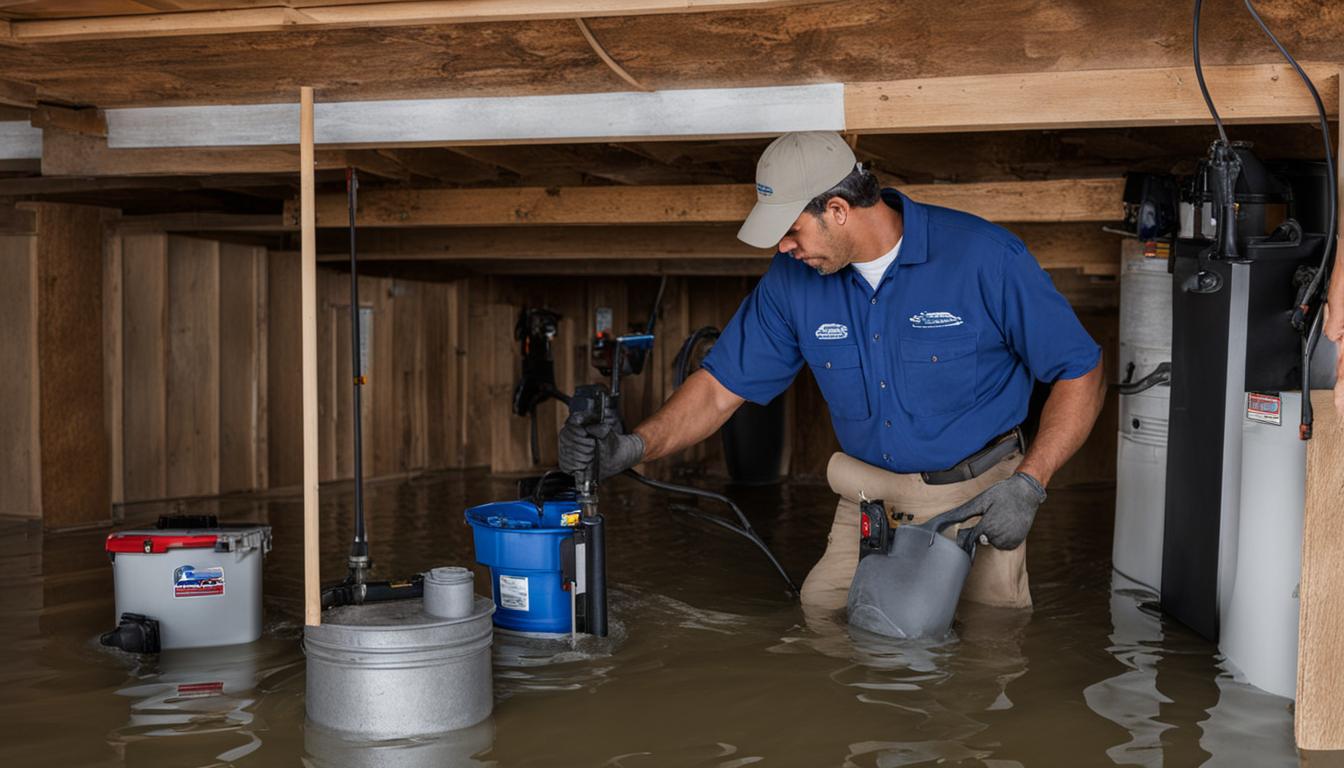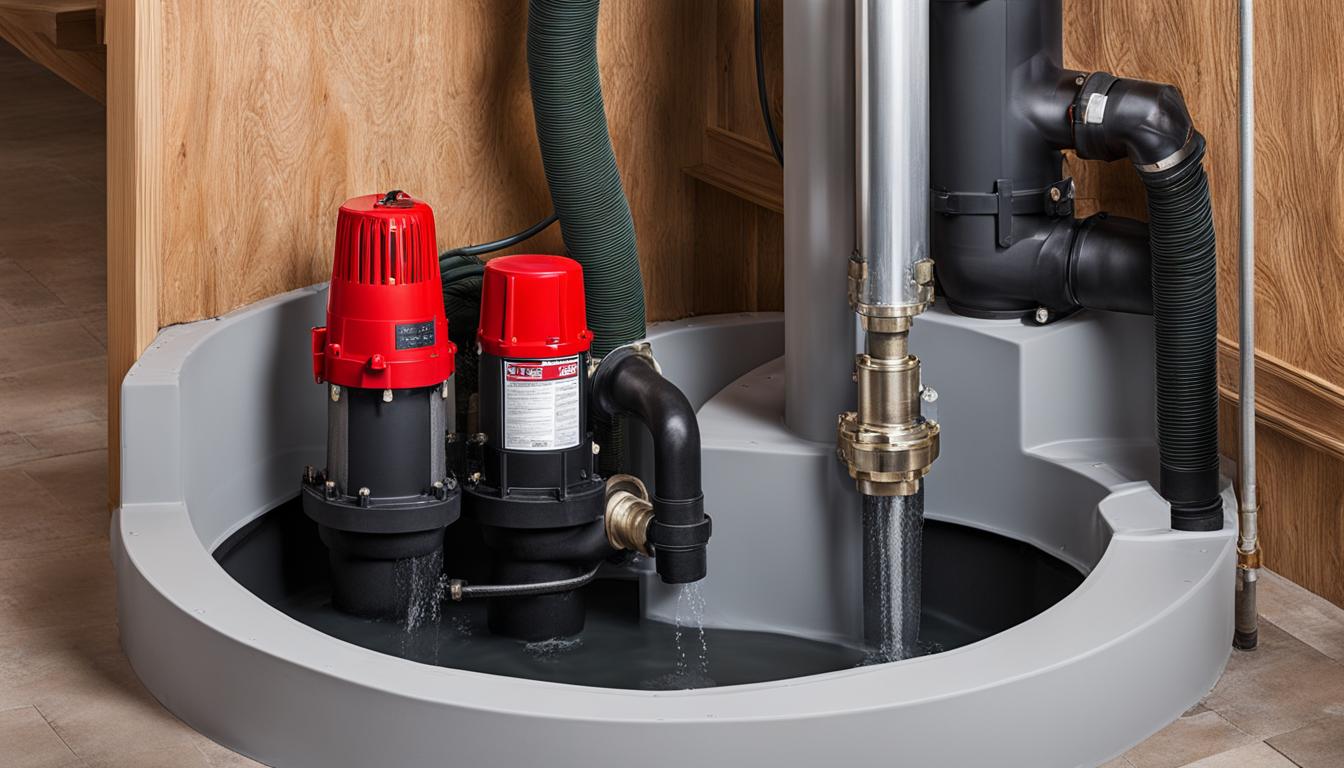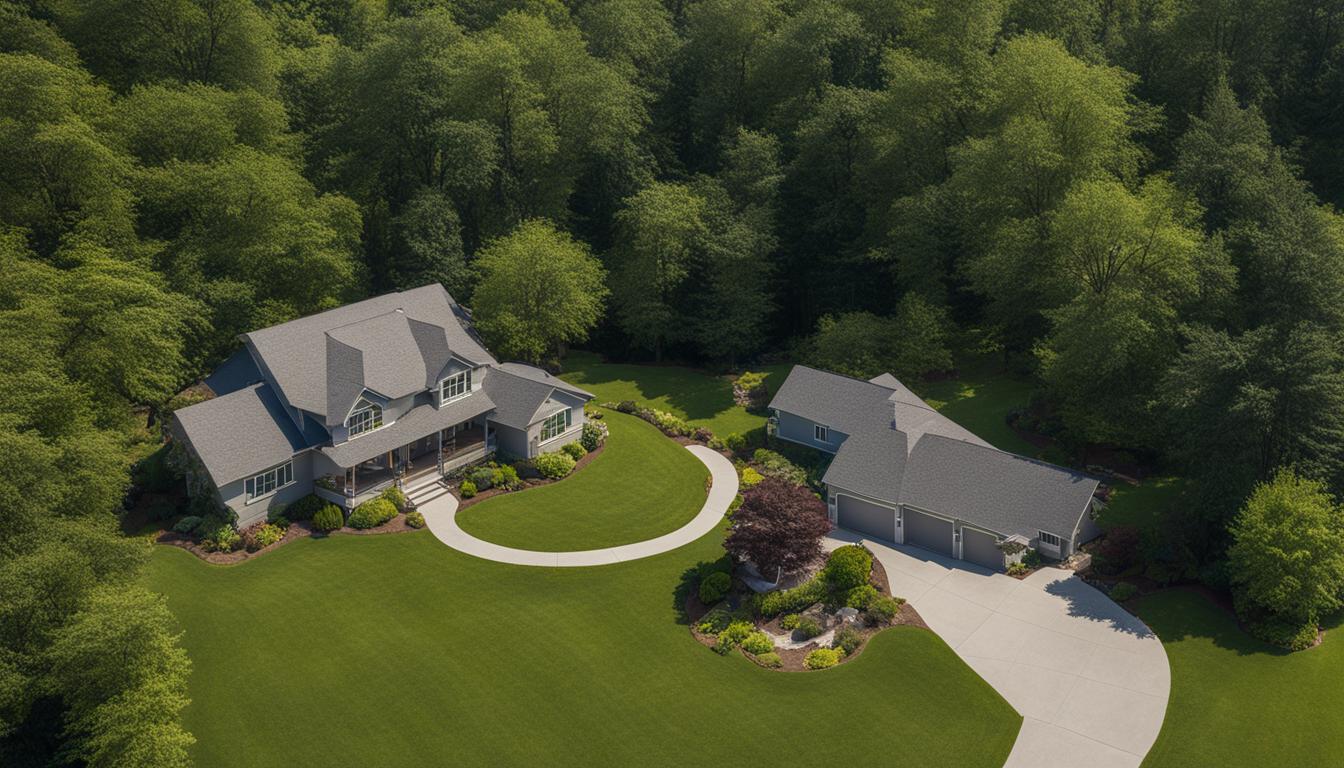As homeowners, we understand the importance of protecting our homes from potential water damage. One of the ways to ensure this is by installing a reliable sump pump system in the basement. However, before installing the sump pump, it’s crucial to determine the appropriate pit size and depth for optimal performance and efficiency.
In this guide, we will provide you with a step-by-step approach to determine the sump pump pit size and depth required for your home. We will discuss factors such as basement conditions, water level management, and efficiency considerations to ensure you make an informed decision about your sump pump installation.
Key Takeaways
- Determining the appropriate sump pump pit size and depth is crucial for optimal performance and efficiency.
- Basement conditions and water level management play a critical role in determining pit size and depth.
- Calculating the required volume and size of the sump pump pit is essential for effective water management.
- Efficiency considerations, including pump cycling frequency and energy consumption, should be optimized for maximum efficiency.
- Proper maintenance and troubleshooting techniques can extend the lifespan of your sump pump system.
Understanding Sump Pump Pit Basics
Before we dive into determining the appropriate size and depth of your sump pump pit, it is essential to understand its basics. A sump pump pit, also known as a sump basin, is an underground reservoir designed to collect water from the basement and pump it out of the house. The pit is usually located in the lowest part of the basement and equipped with a sump pump and a discharge pipe.
Sump pump pits come in different sizes and shapes, with varying depths and capacities. The most common material used for their construction is polyethylene or fiberglass, as they are durable, corrosion-resistant, and easy to install.
The Importance of Capacity Planning
Capacity planning is a critical factor to consider when selecting a sump pump pit. It refers to the ability of the basin and the pump to handle the water inflow rate and pump cycle duration, ensuring optimal performance and efficiency.
To calculate the required capacity of your sump pump pit, you need to determine the basement’s area and the estimated water inflow rate. This information will allow you to choose the appropriate pit size and depth, preventing overflows and pump failures.
| Sump Pump Pit Dimensions | Basement Area | Water Inflow Rate |
|---|---|---|
| 18-inch diameter x 22-inch deep | Less than 500 square feet | 2,000 gallons per hour or less |
| 24-inch diameter x 24-inch deep | 500 to 1,500 square feet | 2,000 to 3,000 gallons per hour |
| 30-inch diameter x 24-inch deep | More than 1,500 square feet | More than 3,000 gallons per hour |
The table above shows some standard sump pump pit dimensions based on the basement area and water inflow rate. While it can serve as a general guideline, it’s essential to evaluate your specific conditions to determine the optimal pit size and depth for your home.
Evaluating Basement Conditions
Before determining the size and depth of your sump pump pit, it’s crucial to evaluate the conditions in your basement. Several factors affect the optimal dimensions of your sump pump pit, which we will explain in detail below.
Basement Size
The size of your basement is a critical factor in determining the appropriate size of your sump pump pit. A larger basement requires a bigger pit to ensure effective water management.
Water Table Level
The water table level in your area affects the appropriate depth of your sump pump pit. If the water table is high, a deeper pit is necessary to prevent water from entering your house.
Existing Drainage Problems
If your basement has existing drainage problems, such as cracks in the walls or floors, it can affect the sizing of your sump pump pit. In such cases, a larger pit may be necessary to handle the increased water flow.
Water Level Management
Understanding how water enters your basement is crucial in determining the size of your sump pump pit. If water enters your basement from the ground, a larger pit with a higher capacity is necessary to handle the water volume. If water enters from other sources such as a leaky pipe, a smaller pit may suffice.
By evaluating these basement conditions, you can make an informed decision about the appropriate size and depth of your sump pump pit, ensuring optimal performance and efficiency of your sump pump system.
Determining Pit Depth Requirements
Now that we have evaluated the basement conditions and water level management, we move on to determining the required depth of your sump pump pit.
It is essential to consider the effects of heavy rainfall or groundwater invasion on your basement. If your basement is prone to flooding, the pit depth should be lower than the basement floor level to allow the pump to remove water effectively. On the other hand, if your basement experiences less frequent water infiltration, the pit depth could be higher than the basement floor level.
The pit depth should be such that the sump pump can operate without frequently turning on and off. If the pit is too shallow, the sump pump will switch on and off more frequently, leading to increased wear and tear, shortening the lifespan of the pump and potentially increasing the risk of failure. Conversely, if the pit is too deep, the pump will operate inefficiently and consume more energy than necessary.
It is ideal to position the sump pump and pit at the lowest point in the basement. This location will ensure that the water flows naturally towards the pit, reducing the risk of water accumulation in other parts of the basement.
Note: In case you’re already dealing with a deep pit, raising the pump using a pedestal sump pump is a viable option to avoid frequent pump cycling.
Calculating the Pit Depth
The pit depth calculation considers the distance between the basement floor level and the water table level. The water level determines how much water needs to be stored in the pit before the pump switches on and starts pumping it out.
| Water Table Level (inches) | Sump Pump Pit Depth (inches) |
|---|---|
| 0-5 | 24-26 |
| 6-10 | 22-24 |
| 11-15 | 20-22 |
| 16-20 | 18-20 |
The above table is a general guideline for determining the required sump pump pit depth based on the water table level. Use these numbers as a starting point while considering other factors such as basement size and water inflow rate.
It is essential to remember that the sump pit’s depth should never exceed the pump’s maximum pumping capacity. Doing so will cause the pump to overwork and may even result in the motor burning out. The sump pump’s maximum pumping capacity is indicated in the product manual, and it is crucial to use this as a reference while determining the sump pump pit depth.
Now that we have discussed the pit depth requirements, let’s move on to calculating the pit size and volume in section 5.
Calculating Pit Volume and Size
Calculating the appropriate volume and size of your sump pump pit involves capacity planning to ensure that the system can handle the water inflow effectively. The following steps will help you determine the required dimensions for your sump pump pit:
- Determine the area of your basement: Calculate the length and width of your basement and multiply them to find the total area in square feet. For example, if your basement measures 20 feet by 30 feet, the total area is 600 square feet.
- Assess water inflow rate: Determine the rate of water inflow into your basement by measuring the amount of water that enters during a rainstorm or by using a flow meter. This measurement will help determine the required pump capacity to handle the water inflow.
- Calculate required sump pump capacity: Calculate the required sump pump capacity by multiplying the water inflow rate by the time it takes to pump out the water from the pit. For example, if the inflow rate is 10 gallons per minute, and the pump takes 2 minutes to discharge the water, the required capacity is 20 gallons.
- Calculate required pit volume: Calculate the required pit volume by multiplying the required pump capacity by the time interval between pump cycles. This calculation will help determine the appropriate size of the sump pump basin. For example, if the pump capacity is 20 gallons, and the pump cycles every 5 minutes, the required pit volume is 100 gallons.
- Calculate required pit size: Calculate the required pit size by adding the pit depth (determined in Section 4) to the required pit volume, then dividing the result by the area of the basin. The result will give you the required depth of the sump pump pit. For example, if the required pit volume is 100 gallons and the pit depth is 24 inches, the total required depth is 34 inches. If the area of the basin is 3 square feet, the required size of the pit is approximately 11 inches by 12 inches.
The above steps will give you the necessary information to determine the appropriate size and volume of your sump pump pit. Proper capacity planning will ensure that your sump pump system can handle the expected water inflow and prevent potential water damage to your home.
Efficiency Considerations for Pit Size and Depth
While choosing the right sump pump pit size and depth is essential for functionality, it also impacts the overall efficiency of your system. To ensure optimal performance, it is crucial to consider efficiency considerations when selecting your sump pump basin.
Did you know? The size and depth of your sump pump pit can impact the frequency at which your pump cycles on and off, affecting energy consumption.
The relationship between pit size, pump cycling frequency, and energy consumption is crucial to understand when selecting your sump pump basin. A larger pit will have a higher water capacity, which means your sump pump will cycle less frequently, reducing energy consumption. On the other hand, a smaller pit will have a lower water capacity, increasing the frequency of pump cycling, which can result in higher energy consumption over time.
When determining the appropriate sump pump pit size and depth, it is essential to balance efficiency with functionality. Consider factors such as the size of your basement, the frequency of water inflow, and pump cycle duration to ensure optimal performance and energy efficiency.
Efficiency Considerations for Sump Pump Basins
Not all sump pump basins are created equal when it comes to efficiency. In general, plastic basins are more efficient than concrete or metal basins due to their lighter weight, which means they require less power to pump water out of the pit. Additionally, plastic basins tend to have smoother interiors, reducing the friction between the water and the basin walls, resulting in more efficient water flow.
When selecting your sump pump basin, consider opting for a plastic option to maximize overall efficiency.
Installation Guide for Sump Pump Pits
Now that you have determined the appropriate sump pump pit size and depth, it’s time to install your sump pump pit. Follow our comprehensive installation guide to ensure a successful and reliable installation.
Tools and Materials
- Shovel
- Tape measure
- PVC pipe and fittings
- Sump pump basin
- Gravel or stone
- Sump pump
- Pump check valve
- PVC primer and cement
- Safety goggles and gloves
Safety Precautions
Before starting your installation, it’s crucial to take the necessary safety precautions. Wear safety goggles and gloves when handling materials that may cause eye or skin irritation, such as PVC primer and cement.
Step-by-Step Instructions
- Start by digging a hole that’s wider and deeper than your sump pump basin. The depth should be at least 2 inches deeper than the basin to allow for a layer of gravel or stone at the bottom.
- Add a 2-inch layer of gravel or stone to the bottom of the hole.
- Place the sump pump basin into the hole and ensure that it’s level.
- Connect the PVC pipe and fittings to the sump pump basin. Install a check valve in the PVC discharge line to prevent water from flowing back into the basin.
- Install the sump pump into the basin and connect it to the PVC discharge pipe following the manufacturer’s instructions.
- Test the sump pump by pouring water into the basin until the float switch activates the pump.
- Fill the hole around the basin with gravel or stone and cover the top of the basin with a lid.
- Connect the discharge pipe to a suitable outlet, such as a storm drain or French drain.
Additional Tips
Keep in mind that the sump pump should be secured to the basin to prevent it from shifting during operation. It’s also important to regularly inspect and clean the sump pump basin to ensure proper functioning.
Following our installation guide will ensure that your sump pump system is installed correctly and ready to protect your home from potential water damage.
Maintenance and Troubleshooting Tips
Regular maintenance is essential to keep your sump pump system operating efficiently and effectively. Here are some sump pump maintenance tips to ensure your system stays in good condition:
- Inspect the sump pump pit: Regularly check the sump pump pit for debris buildup or any other blockages that could hinder the proper function of the sump pump. Clean out any debris or sediment that may have accumulated.
- Test the sump pump: To ensure that the sump pump is working correctly, conduct a test run by pouring water into the sump pump pit and observing the pump’s action. This test should be done at least once a year.
- Check the float switch: The float switch is responsible for turning the sump pump on and off. Regularly test the switch to ensure that it is functioning correctly and not stuck or obstructed.
- Replace the battery backup: If your sump pump has a battery backup, it is essential to replace the battery regularly to ensure that it will function correctly in the event of a power outage.
- Inspect the discharge line: Make sure that the sump pump discharge line is clear and not blocked in any way. If necessary, use a plumber’s snake to remove any blockages.
If you encounter any issues with your sump pump system, the following sump pump troubleshooting tips may help you in resolving the problem:
- No power: If the sump pump is not receiving power, check the circuit breaker and ensure that it has not tripped. If the breaker has not tripped, check the power cord and outlet for any damages or disconnections.
- Strange noises: If you hear any unusual sounds coming from the sump pump, such as grinding or rattling, this could indicate a problem with the impeller or motor. Turn off the sump pump and contact a professional for repairs.
- No water discharge: If the sump pump is not discharging water correctly, check for any clogs in the discharge line. If there are no clogs, it could be an issue with the float switch or pump itself. Contact a professional for repairs.
- Continuous running: If the sump pump continues to run even when there is no water in the pit, this could indicate a problem with the float switch. Check the switch for any obstructions or damages and have it replaced if necessary.
- Backup system failure: If your sump pump has a battery backup system and it fails to activate during a power outage, check the battery for any damages or corrosion and replace it if necessary. If the battery is not the issue, contact a professional for repairs.
Conclusion
Deciding on the right sump pump pit size and depth is crucial for the success of your basement water management system. After evaluating basement conditions and calculating the required volume, you can determine the appropriate dimensions for your sump pump pit. Remember to consider efficiency factors such as pump cycling frequency and energy consumption to optimize your system’s performance.
Following our step-by-step guide to sump pump pit installation and maintenance will ensure your system runs smoothly, efficiently and provides you with confidence that your home is protected from potential water damage. Contact us for more information on sump pump pits and how we can assist you in selecting and installing the right system.
FAQ
How do I determine the size and depth of my sump pump pit?
To determine the size and depth of your sump pump pit, you need to evaluate factors such as basement conditions, water level management, and efficiency considerations. Our guide provides step-by-step instructions on how to calculate the required dimensions based on your specific needs.
What is the purpose of a sump pump pit?
A sump pump pit serves as a collection basin for water that enters your basement. It helps prevent flooding and water damage by efficiently managing and removing excess water. By installing a sump pump in the pit, the system can effectively pump out the collected water and keep your basement dry.
How does basement size affect the sump pump pit dimensions?
The size of your basement is an important consideration when determining the dimensions of your sump pump pit. A larger basement may require a bigger pit to accommodate a higher volume of water. It is essential to calculate the appropriate pit size based on the area you need to protect from potential flooding.
Why is capacity planning important for sump pump pits?
Capacity planning is crucial for sump pump pits because it ensures that the pit and the pump can handle the expected volume of water. By considering factors such as the water inflow rate, pump cycle duration, and the size of your basement, you can determine the required capacity for your sump pump system and prevent overflow or underperformance.
How do heavy rainfall and groundwater invasion affect sump pump pit depth?
Heavy rainfall and groundwater invasion can significantly impact the water levels in your basement. It is important to consider these factors when determining the depth of your sump pump pit. By understanding the potential water level fluctuations, you can calculate the appropriate pit depth to ensure that your sump pump can effectively manage these variations and prevent flooding.
How do I calculate the volume and size of my sump pump pit?
Calculating the volume and size of your sump pump pit involves considering factors such as the basement area, water inflow rate, and pump cycle duration. Our guide provides detailed instructions on how to perform these calculations accurately to ensure that you select the right pit dimensions for your specific needs.
What are the efficiency considerations for sump pump pit size and depth?
The size and depth of your sump pump pit can impact the overall efficiency of your system. By optimizing the pit dimensions, you can minimize the pump cycling frequency and reduce energy consumption. Our guide explains how these efficiency considerations can help you maximize the performance of your sump pump system while minimizing costs.
Are there any specific installation guidelines for sump pump pits?
Yes, there are specific installation guidelines for sump pump pits to ensure a successful and reliable system. Our comprehensive installation guide provides step-by-step instructions, lists the required tools, and includes important safety precautions. Following these guidelines will help you install your sump pump pit correctly and avoid potential issues in the future.
How do I maintain and troubleshoot my sump pump system?
Proper maintenance is essential to keep your sump pump system running smoothly. Our guide offers valuable maintenance tips and troubleshooting techniques to address common issues that may arise. By following these guidelines, you can extend the lifespan of your sump pump and ensure that it remains in optimal condition for effective water management in your basement.




